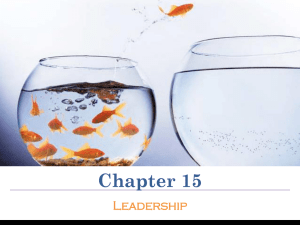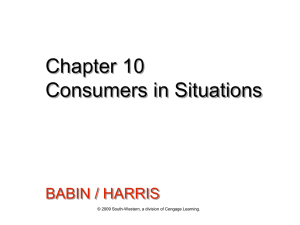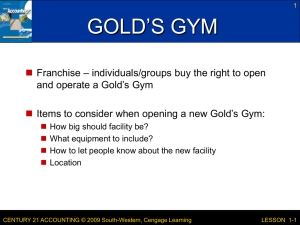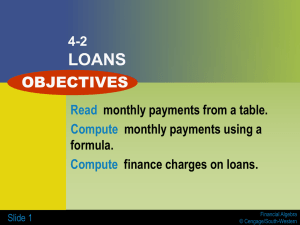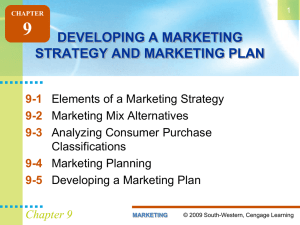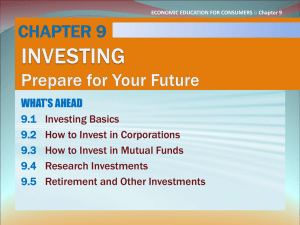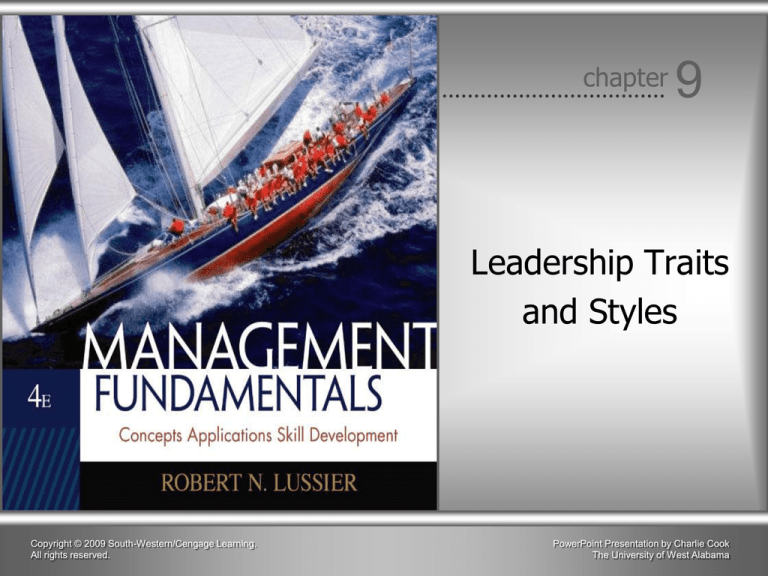
chapter
9
Leadership Traits
and Styles
Copyright © 2009 South-Western/Cengage Learning.
All rights reserved.
PowerPoint Presentation by Charlie Cook
The University of West Alabama
Leadership
• What is leadership?
The process of influencing employees to work toward
the achievement of organizational objectives.
• Is leadership the same as management?
No. Leadership is a functional activity incorporated
within the broader scope of management activities. It
is part of planning, leading, organizing and
controlling.
There are managers who are not leaders and there
are leaders who are not managers. Managers lacking
the ability to influence others are not true leaders.
Copyright © 2009 South-Western/Cengage Learning. All rights reserved.
9–2
Let’s go to the Big Apple….American
Express
• 65,000 employees
• CEO-Ken Chenault-worked his way up the
ladder over 20 years
• Ken is one of few African American CEOs of a
Fortune 500 company
• Tough but fair manager who gets results
• Became CEO just 9 months before 9/11
• 11 employees were killed, thousands of
customers were stranded, headquarters had to
close
Copyright © 2009 South-Western/Cengage Learning. All rights reserved.
9–3
Leadership Trait Theory
• Leadership Trait Theorists
Attempt to determine a list of distinctive
characteristics that account for leadership
effectiveness.
But in over 70 years and 300 trait studies, they
weren’t able to identify a universal set of traits that all
leaders possess.
• The Ghiselli Study (1971)
Edwin Ghiselli studied over 300 managers from 90
different businesses in the US
He concluded that certain traits are important to
effective leadership:
(in this order)….
Copyright © 2009 South-Western/Cengage Learning. All rights reserved.
9–4
Ghiselli’s 6 Traits of Effective Leadership1.
2.
3.
4.
5.
6.
Supervisory ability- getting the job done through
others
Need for occupational achievement- seeking
responsibility and wanting to work hard
Intelligence- good judgment/sound reasoning
Decisiveness- solve problems, make decisions
competently
Self-assurance- viewing oneself as capable and
behaving likewise
Initiative-being a self starter
Copyright © 2009 South-Western/Cengage Learning. All rights reserved.
9–5
What are some of Ken Chenault’s
Leaderships Traits?
• Supervisory ability-he gets subordinates to
perform according to his expectations
Changed a poorly performing merchandise unit into a
profitable one early in his career
• Has a strong need for occupational
advancement• Also has intelligence, decisiveness and takes
initiative
Copyright © 2009 South-Western/Cengage Learning. All rights reserved.
9–6
Behavioral Leadership Theories
• Behavioral Leadership Theorists
Who were they? Early researchers who attempted to
identify the “best leadership style” for all situations.
Attempted to determine distinctive styles used by effective
leaders.
Focused on the leaders’ behaviors
Also focused on the relationship between leaders and
followers.
• What are the 3 parts of leadership style?
The combination of traits, skills, and behaviors
managers use in interacting with employees.
Copyright © 2009 South-Western/Cengage Learning. All rights reserved.
9–7
What Would You Do?
• Do the self assessment on pg. 320
• Remember your score as we discuss leadership
styles.
Copyright © 2009 South-Western/Cengage Learning. All rights reserved.
9–8
3 Basic Leadership Styles
• Autocratic Leader
One who makes all the decisions, tells employees
what to do, and closely supervises employees.
Considered a Theory X-type leader.
• Democratic Leader
One who encourages employee participation in
decisions, works with employees to determine what to
do, and does not closely supervise employees.
Considered a Theory Y-type leader.
Copyright © 2009 South-Western/Cengage Learning. All rights reserved.
9–9
3 Basic Leadership Styles (cont’d)
• Laissez-Faire Leader
One who takes a leave-employees-alone approach,
allowing them to make the decisions and decide what
to do, and does not follow up.
Copyright © 2009 South-Western/Cengage Learning. All rights reserved.
9–10
Two-Dimensional Leadership Styles
• Two-Dimensional (4 Leadership Styles)
Based on job structure and employee consideration,
which result in four possible leadership styles.
The Ohio State University (1945)
1) Structuring (geared around the job)
– The extent to which the leader takes charge to plan, organize,
lead, and control as the employee performs the task.
2) Consideration (geared around the employee)
– The extent to which the leader communicates to develop trust,
friendship, support, and respect.
University of Michigan (1945)
3) Job-centered
– Similar to structuring. (above)
4) Employee-centered
– Similar to consideration (above)
Copyright © 2009 South-Western/Cengage Learning. All rights reserved.
9–11
Exhibit 9–1 ● The Ohio State University and University of Michigan TwoDimensional Leadership Styles
Copyright © 2009 South-Western/Cengage Learning. All rights reserved.
9–12
The Leadership Grid®
• The Leadership Grid® (5 Leadership Styles)
Believes that the ideal style incorporates a high concern for both
the job (or production) and the employee.
• Leadership Styles (5)
Impoverished management style (1, 1)-leader does the minimum
required to remain employed
Authority-compliance management style (9, 1)-leader treats
people like machines
Country-club management style (1, 9)-leader makes a friendly
atmosphere but doesn’t care about production
Middle-of-the-road management style (5, 5)-medium concern for
people and job but gets minimal satisfactory performance
Team management style (9, 9)-strives for maximum
performance and maximum employee satisfaction
Copyright © 2009 South-Western/Cengage Learning. All rights reserved.
9–13
The Leadership Grid® (Blake and McCanse)
Copyright © 2009 South-Western/Cengage Learning. All rights reserved.
9–14
Copyright © 2009 South-Western/Cengage Learning. All rights reserved.
9–15
What Leadership Style does Ken Chernault
use?
• Team management (most often)
• But sometimes like just after 9/11 he used the
country club style because he showed a higher
concern for the emotional and safety needs of
employees while placing production on the back
burner
Copyright © 2009 South-Western/Cengage Learning. All rights reserved.
9–16
What Kind of Boss Do You Have?
• Each site should be a group.
• Each student at each site should take turns
thinking of a present or past boss they had.
Which of the 5 major leadership styles did he or
she use most often? (impoverished, authoritycomplianance, country club, middle of the road,
or team management). Describe your boss’s
behavior to the rest of the group and which style
you think he or she used.
• Students should explain why they agree or
disagree with the other students’ findings.
Copyright © 2009 South-Western/Cengage Learning. All rights reserved.
9–17
Contemporary Perspectives (5)
• Charismatic Leadership
A leadership style that inspires loyalty, enthusiasm, and
high levels of performance.
Most appropriate for top management.
• Transformational Leadership
A leadership style that brings about continuous learning,
innovation, and change.
Most appropriate for top management.
• Transactional Leadership
A leadership style based on exchange. “You do this for me
and I’ll give this reward to you.”
Useful for middle or first line management
Copyright © 2009 South-Western/Cengage Learning. All rights reserved.
9–18
Contemporary Perspectives (cont’d)
• Symbolic Leadership
A leadership style based on establishing and
maintaining a strong organizational culture.
Employees learn by example.
Should start at the top and flow down.
• Servant Leadership
A leadership style based on simultaneously meeting
the needs and goals of employees and the goals of
the organization.
Focuses on motivating employees by meeting their higherlevel needs.
Motivates employees to go beyond role requirements and do
what it takes
to attain
the goals of the organization.
Copyright © 2009 South-Western/Cengage
Learning.
All rights reserved.
9–19
Is Ken Chenault a Charismatic Leader?
What about Transformational? A Servant
Leader? Symbolic?
• He’s all of the above!
Charismatic-”When you work with Ken Chenault, you feel you’ll
do anything for him.”
Transformational-He had the courage to challenge the old
culture at American Express and change it.
Symbolic leader during the 9/11 crisis
Servant leader-Two weeks after 9/11 he gathered the employees
together for a “town hall meeting” and personally comforted griefsticken employees. Also pledged $1 million of profits to the
families of American Express victims. He said “You represent
American Express. All the people of American Express are what
this company is all about. In fact, you are my strength and I love
you.”
Copyright © 2009 South-Western/Cengage Learning. All rights reserved.
9–20
Situational Approaches to Leadership (6)
• Up until the 1960s, they were trying to find the best leadership style for all
situations but no single style is best for all situations.
• Situational Leadership Theorists (1960s)
Attempted to determine the appropriate leadership
style for various situations.
1-Contingency leadership model
2-Leadership continuum model
3-Path-goal model
4-Normative leadership theory
5-Situational Leadership® model
6-Leadership substitutes and neutralizers
“Should the leader change his/her style or should the
situation be changed to fit the leader’s style?”
Copyright © 2009 South-Western/Cengage Learning. All rights reserved.
9–21
Contingency Leadership Model
• (1)Contingency Leadership Model (Fiedler)
Used to determine if one’s leadership style is task- or
relationship-oriented and if the situation matches the
leader’s style.
Leadership style
The Least Preferred Coworker (LPC) scale measures a
leader’s task (job) or relationship (employee) orientation.
Situational favorableness
Leader-follower relations (good or poor?)
Task structure (structured or unstructured?)
Position power (strong or weak?)
Criticism: If the style doesn’t work, sometimes it’s very
hard to change the situation.
Copyright © 2009 South-Western/Cengage Learning. All rights reserved.
9–22
Exhibit 9–2 ● Contingency Leadership Model
Copyright © 2009 South-Western/Cengage Learning. All rights reserved.
9–23
Copyright © 2009 South-Western/Cengage Learning. All rights reserved.
9–24
Is McDonald’s company task oriented or
relationship oriented?
Copyright © 2009 South-Western/Cengage Learning. All rights reserved.
9–25
Leadership Continuum Model
• (2)Leadership Continuum Model (Tannenbaum
and Schmidt)
Used to determine which of seven styles of leadership, on a
continuum from autocratic (boss-centered) to participative
(employee-centered), is best for a given situation.
Focuses on who makes the decisions
Factors determining selection of style:
The leader’s preferred style
The subordinates’ preferred style for the leader
The situation
– Organization’s size, structure, climate, goals, technology, and
higher-level management leadership style and the time available
Criticism: The 3 factors above can be subjective, so determining
which style to use in a given situation can be difficult.
Copyright © 2009 South-Western/Cengage Learning. All rights reserved.
9–26
Does Ken Chenault ever change his
leadership style?
• Yes! To focus on tasks or relationships.
• Immediately after hearing that the World Trade
Center had collapsed, he used the autocratic style to
make the decision to evacuate the American Express
building across the street and to hire private planes
to transport stranded American Express customers.
• But the style he uses most often is participative.
Copyright © 2009 South-Western/Cengage Learning. All rights reserved.
9–27
Exhibit 9–3 ● The Leadership Continuum
Source: Adapted from Robert Tannenbaum and Warren Schmidt, “How to Choose a Leadership Pattern,” Harvard Business Review (May/June,
1973).
Copyright © 2009 South-Western/Cengage Learning. All rights reserved.
9–28
Copyright © 2009 South-Western/Cengage Learning. All rights reserved.
9–29
(3)Path-Goal Model
• Path-Goal Model (House)
Used to determine employee objectives and to clarify how to
achieve them using one of four leadership styles.
Considers subordinates’ situational factors and environmental
factors in determining a leadership style.
Leadership styles:
Directive
– The leader provides high structure.
Supportive
– The leader provides high consideration.(develops trust and respect)
Participative
– The leader considers employee input when making decisions.
Achievement-oriented
– The leader sets difficult but achievable goals, expects subordinates to
perform at their highest level, and rewards them for doing so
Criticism: hard to know which style to use in a given situation.
Copyright © 2009 South-Western/Cengage Learning. All rights reserved.
9–30
Exhibit 9–4 ● A Summary of Path-Goal Factors and Styles
Situational Factors
Subordinate
authoritarianism
locus of control
ability
Environmental
task structure
formal authority
work group
determine
Leadership Styles
Directive
Supportive
Participative
Achievement-oriented
Copyright © 2009 South-Western/Cengage Learning. All rights reserved.
that affect
Goal Achievement
Performance
Satisfaction
9–31
(4)Normative Leadership Model
• Normative Leadership Model (Vroom and Jago)
A decision tree that enables the user to select one of
five leadership styles appropriate for a situation.
Determination of leadership style is based on two
factors:
The importance of individual versus group decisions (input
and participation).
The importance of time-driven versus development-driven
decisions (time-pressure and quality of decision).
Criticism: cumbersome to select from 4 types of
decisions and an 8 question decision tree every time
you need to choose a style.
Copyright © 2009 South-Western/Cengage Learning. All rights reserved.
9–32
(5)Situational Leadership® Model
• Situational Leadership® Model (Hersey and Blanchard)
Used to select one of four leadership styles that match the
employees’ maturity level in a given situation.
(Maturity level doesn’t mean how grown up an employee is but
rather how competent, commited and ready to do the job he is.)
Telling
– Giving employees explicit directions about how to accomplish a task.
Selling
– Explaining decisions to gain understanding.
Participating
– Facilitating decision making among subordinates.
Delegating
– Giving employees responsibility for their decisions and their
implementation.
Copyright © 2009 South-Western/Cengage Learning. All rights reserved.
9–33
Copyright © 2009 South-Western/Cengage Learning. All rights reserved.
9–34
Exhibit 9–5 ● A Comparison of Behavioral and Situational Leadership Models
Copyright © 2009 South-Western/Cengage Learning. All rights reserved.
9–35
(6)Leadership Substitutes Theory
• Can the leader be replaced by something?
Characteristics of the task, of subordinates, or of the
organization can replace the need for a leader.
Subordinates—ability, knowledge, experience, training; need
for independence, professional orientation; indifference
toward organizational rewards
Task—clarity, routineness, invariant methodology; provision
of feedback concerning accomplishment and of intrinsic
satisfaction
Organization—formality; inflexibility; very specific advisory
and staff functions; closely knit, cohesive work groups;
rewards outside of the leader’s control; physical distance
between superior and subordinates
Copyright © 2009 South-Western/Cengage Learning. All rights reserved.
9–36


